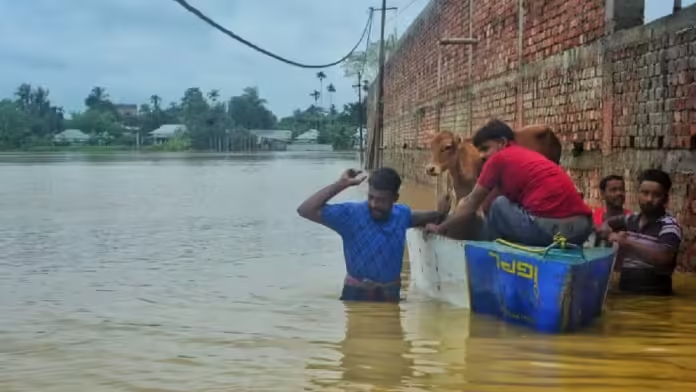The state of Tripura has been severely impacted by devastating floods, affecting over 17 lakh people across various districts. The unprecedented rainfall and subsequent flooding have wreaked havoc, displacing thousands and claiming the lives of at least 20 individuals. As the situation continues to escalate, rescue and relief operations are in full swing, with authorities striving to provide shelter and essential supplies to the affected population.
Widespread Impact Across Tripura
The floods have caused widespread destruction in Tripura, with several districts, including West Tripura, Dhalai, and Gomati, bearing the brunt of the disaster. Continuous heavy rainfall has led to rivers breaching their banks, submerging large areas of agricultural land, and inundating residential areas. The extent of the damage is vast, with many roads and bridges either destroyed or rendered impassable, severely hampering relief efforts.
Thousands Seek Shelter in Relief Camps
In response to the crisis, the state government has set up numerous relief camps across the affected regions. According to official reports, over 65,400 people have sought refuge in these camps, where they are being provided with food, water, and medical aid. The administration is working tirelessly to ensure that the displaced individuals receive the necessary support, but the sheer scale of the disaster has stretched resources thin.
Rising Death Toll and Health Concerns
As the floodwaters continue to rise, the death toll has tragically reached 20, with fears that the number could climb higher. Many of the fatalities have been attributed to drowning, landslides, and electrocution. In addition to the immediate dangers posed by the floods, there is growing concern about the potential outbreak of waterborne diseases in the overcrowded relief camps.
Health officials are on high alert, with teams deployed to monitor the situation and prevent the spread of infections. The state government has also appealed to the central government for additional medical supplies and personnel to assist in managing the crisis.
Government and Community Response
The state government, led by Chief Minister Biplab Kumar Deb, has been coordinating with central agencies to expedite rescue and relief operations. The Indian Army, National Disaster Response Force (NDRF), and State Disaster Response Force (SDRF) have all been mobilized to assist in evacuating people from the worst-affected areas and distributing relief materials.
In addition to government efforts, various non-governmental organizations (NGOs) and community groups have stepped in to provide assistance. Volunteers are working alongside officials to distribute food, clean water, and other essentials to those in need.
Economic and Agricultural Losses
The floods have also dealt a severe blow to Tripura’s economy, particularly its agricultural sector. Thousands of hectares of crops have been destroyed, raising concerns about food security in the coming months. The state, which relies heavily on agriculture, is expected to face significant economic challenges as it grapples with the aftermath of the disaster.
Appeal for Aid and Future Preparedness
In light of the ongoing crisis, the Tripura government has issued an urgent appeal for aid from the central government and international organizations. Financial assistance, along with resources such as food, water, and medical supplies, is crucial to support the relief and rehabilitation efforts.
Looking ahead, there is also a pressing need for improved disaster preparedness and infrastructure in Tripura to mitigate the impact of future floods. Strengthening early warning systems, enhancing river embankments, and implementing effective flood management strategies are essential steps to safeguard the state from similar disasters in the future.
The Tripura floods have left a devastating impact on the state, with over 17 lakh people affected and thousands seeking shelter in relief camps. As the death toll continues to rise, the focus remains on providing immediate relief to the affected population while addressing the long-term challenges posed by the disaster. The collective efforts of the government, community organizations, and volunteers will be crucial in helping Tripura recover from this calamity and build resilience against future floods.




